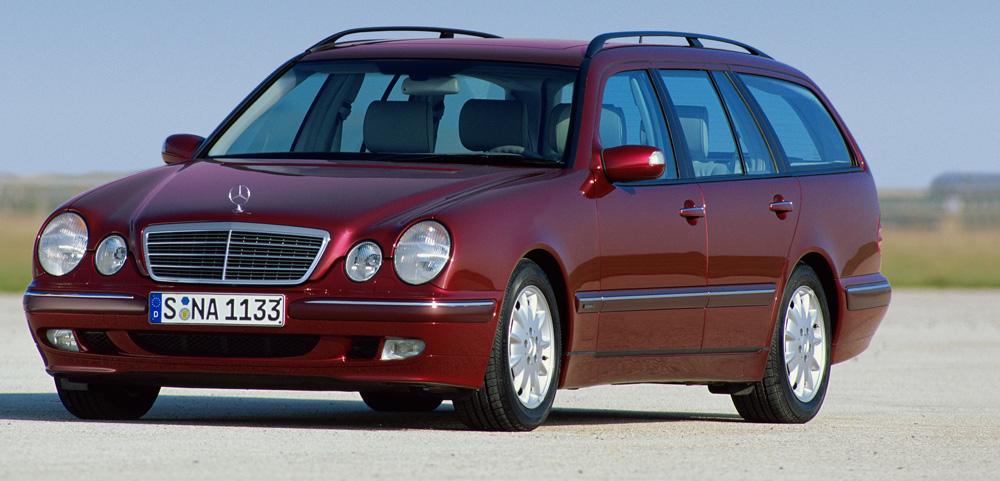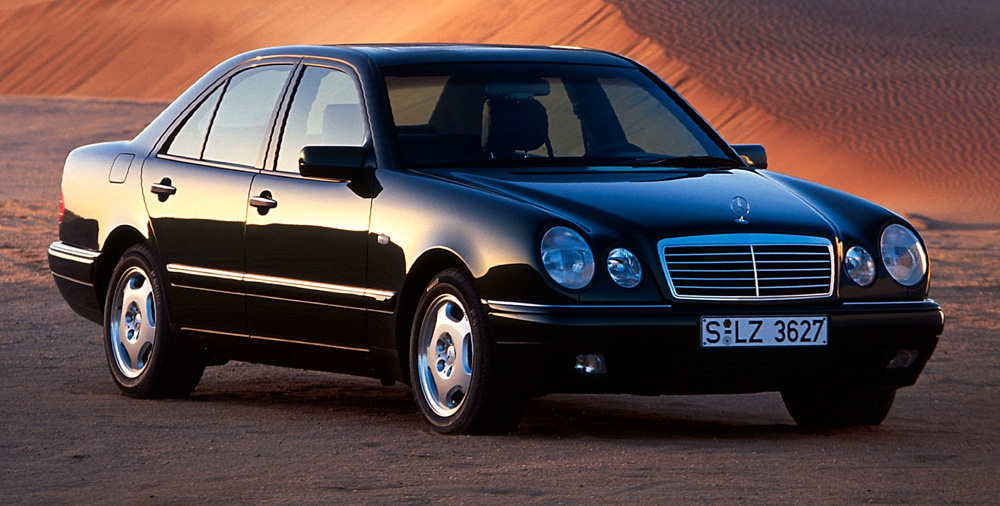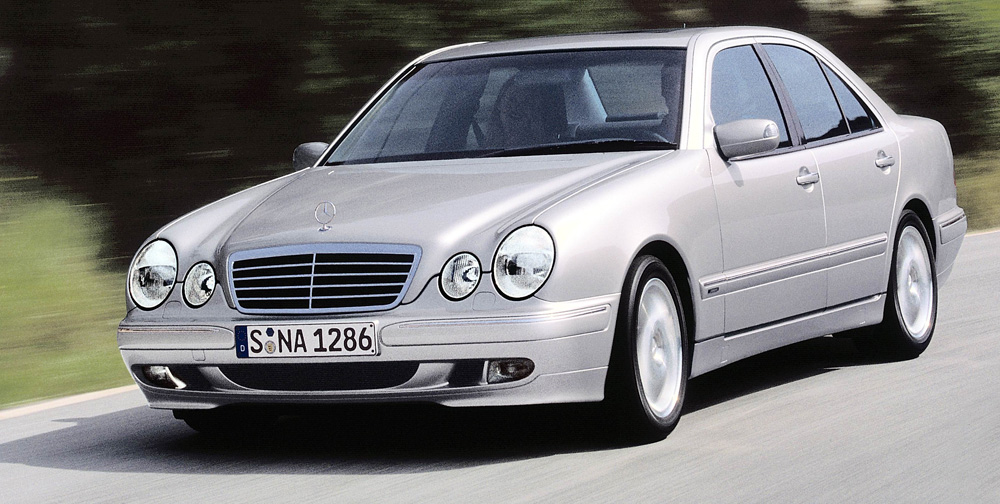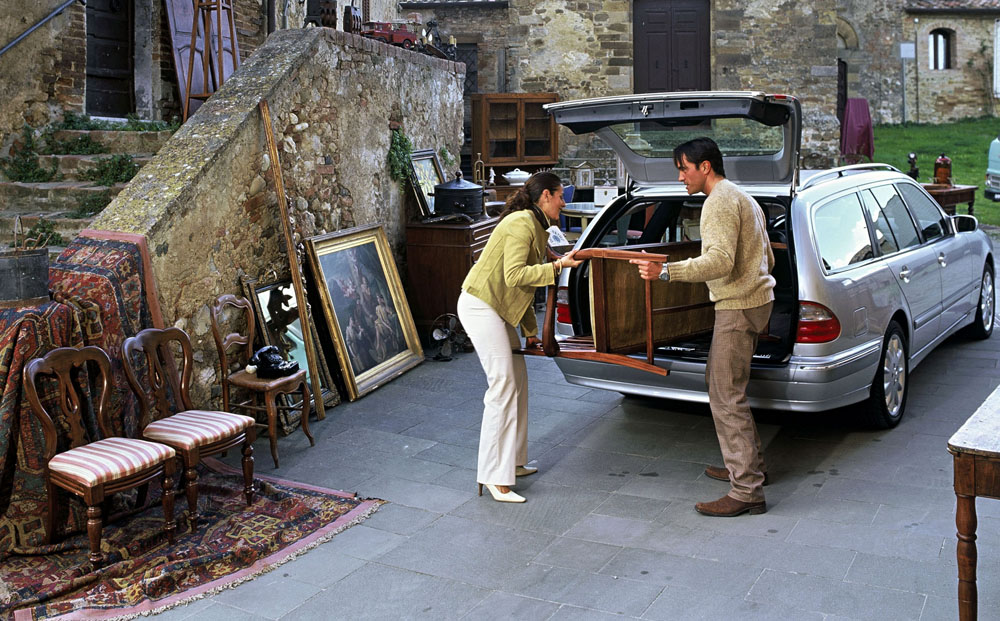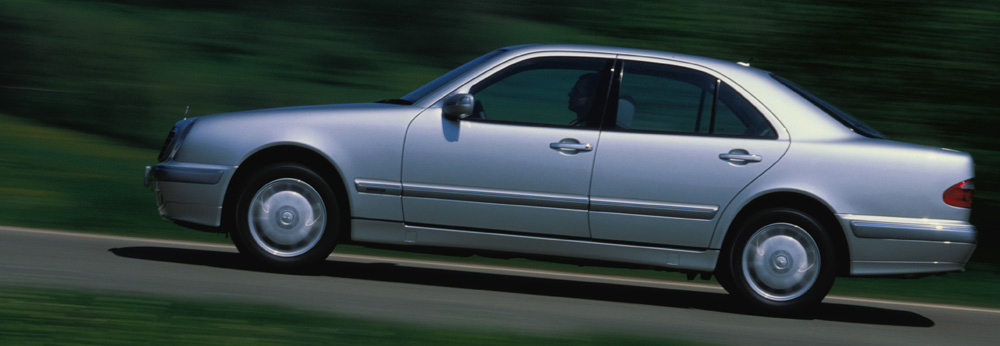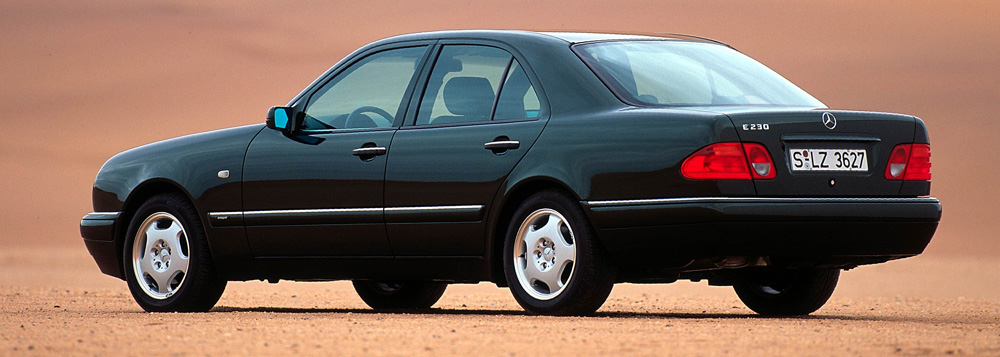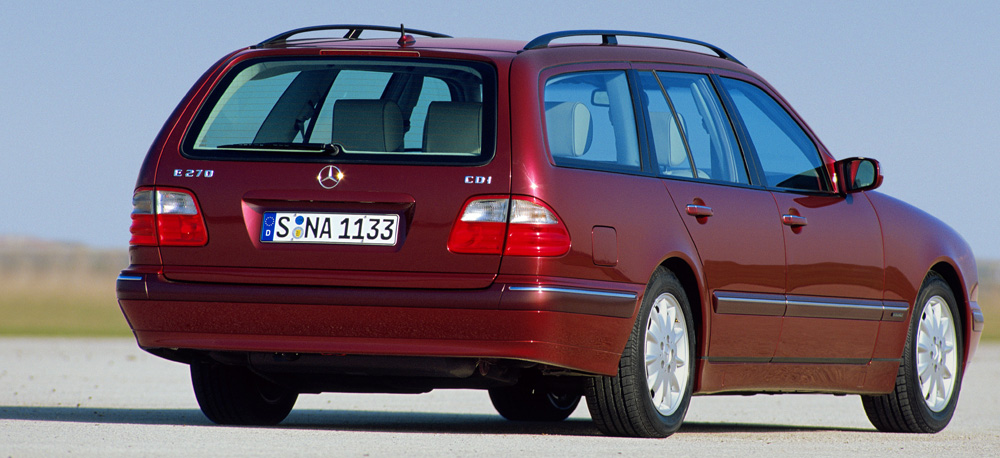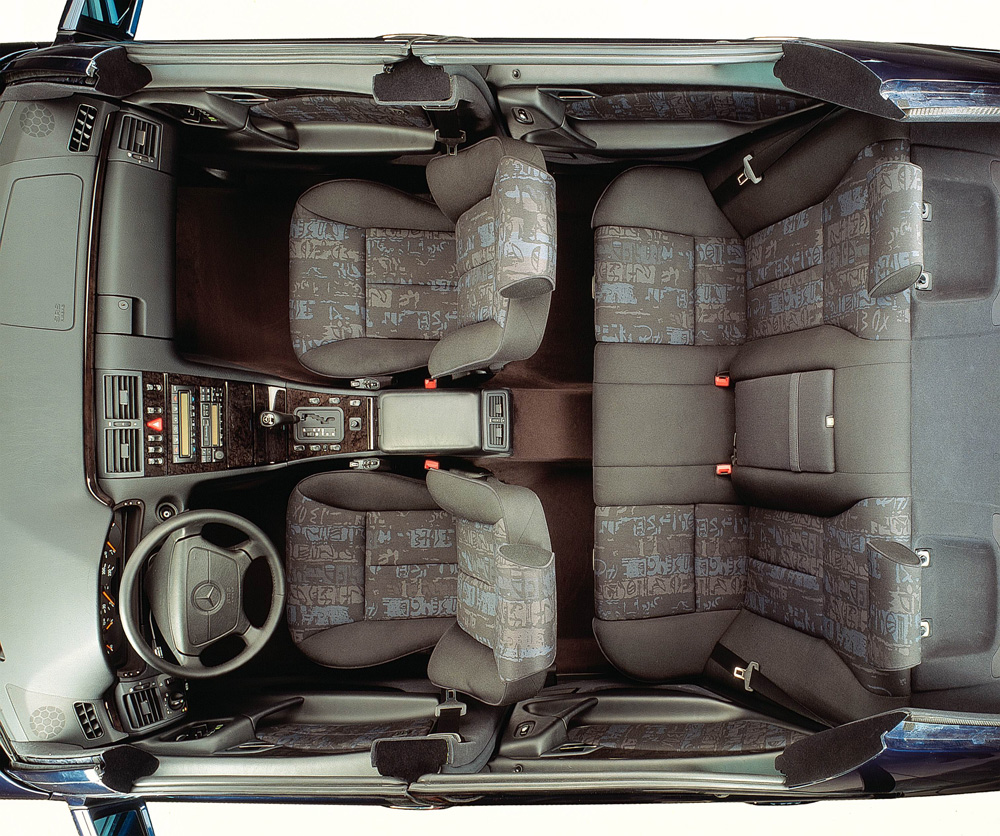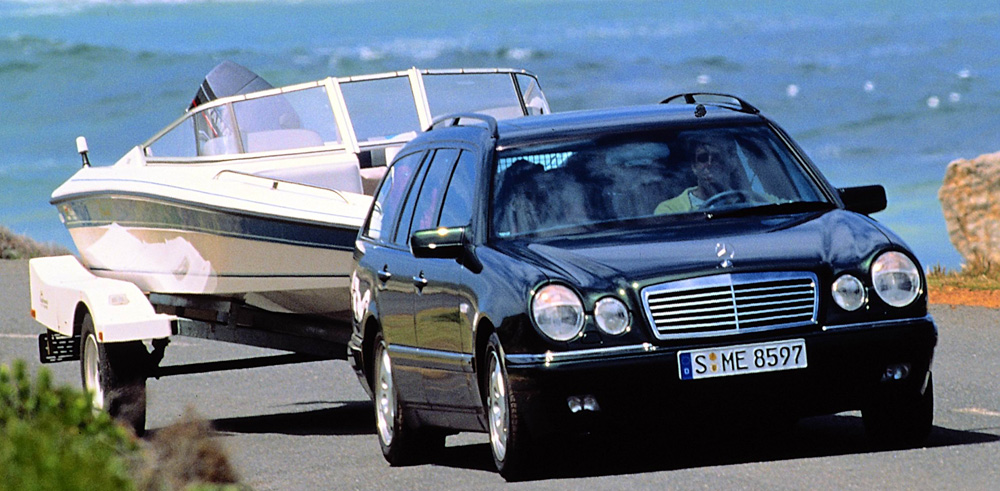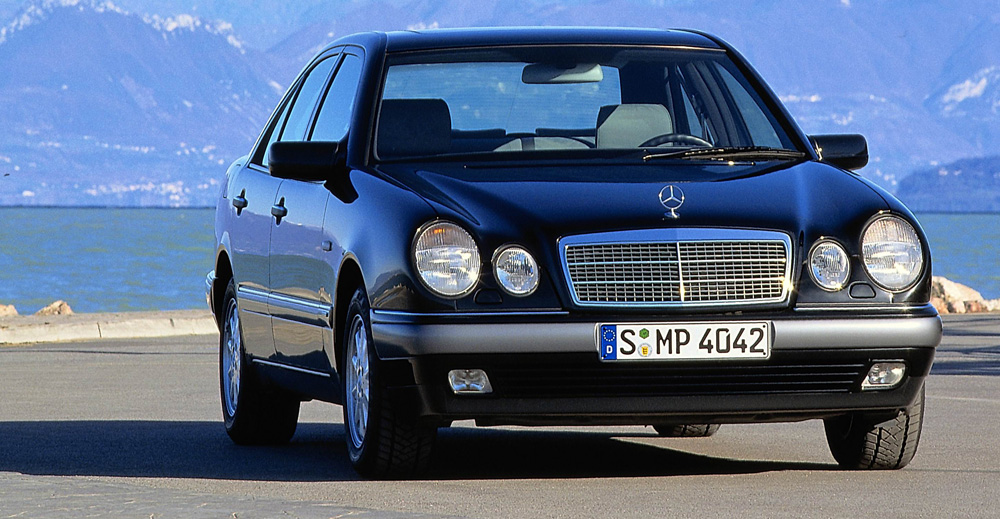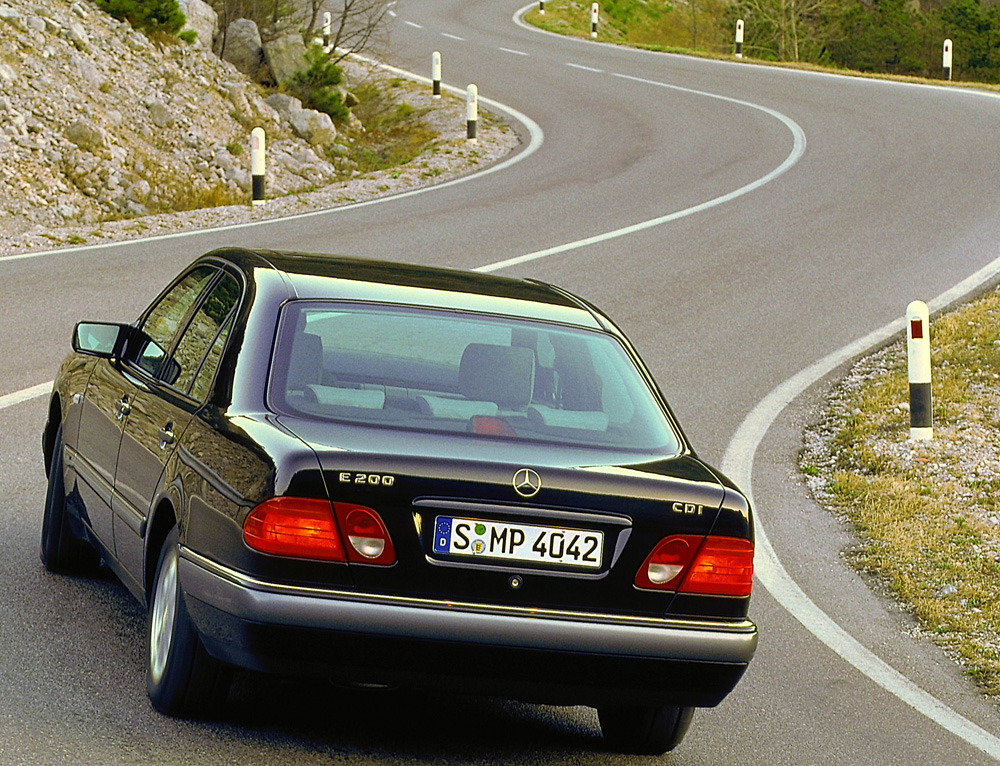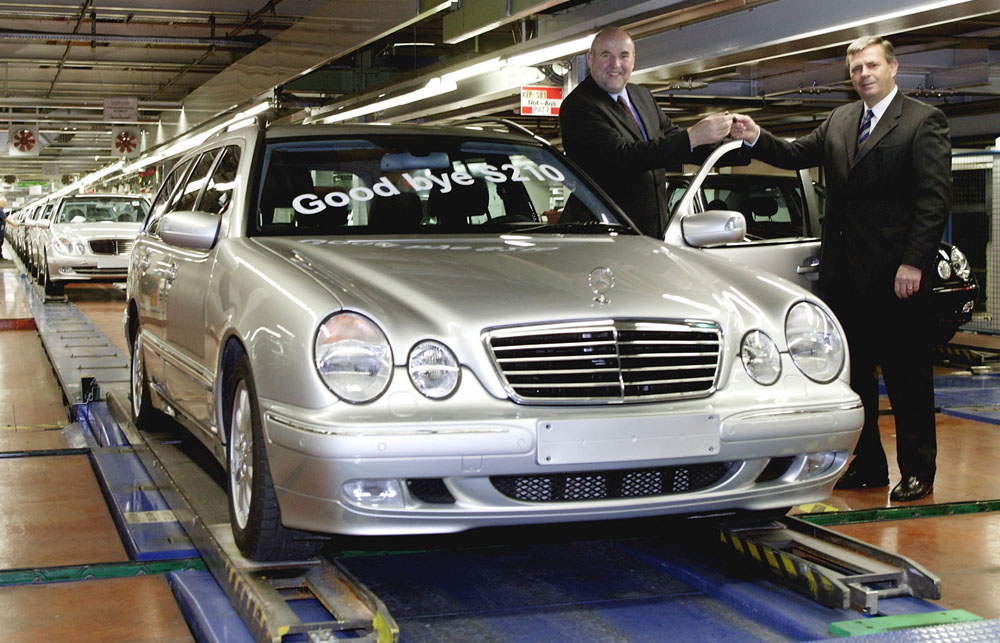|
|
|
Mercedes-Benz E-Class 210 series (1995 to 2003) When the new E-Class of the 210 series made its debut in June 1995, the saloon saw the world through very different eyes: for the first time a Mercedes-Benz E-Class had a striking front end featuring four elliptical headlamps. The coupe-like design of the rear end also caused quite a stir. These two design elements, a distinct contrast to the relatively stringent lines of the 124 series, were very well received by experts and public alike. Straightaway the W 210 was awarded the renowned "red dot design award". But it was not only its distinctive shape that set the new E-Class apart. It incorporated more than 30 technical innovations. Another remarkable feature was its sensationally low drag coefficient of 0.27. The organisation of the appointments was also entirely new: from the 202 series C-Class the planners adopted the concept of different design and equipment lines. There were three variants to chose from: CLASSIC, ELEGANCE and AVANTGARDE. Compared with the basic version, CLASSIC, distinguished by its deliberately low-key appearance, the ELEGANCE variant offered a number of additional items for the interior and exterior. Ten-hole light-alloy wheels and chrome trim on the door handles, bumpers and the side rub strips. The AVANTGARDE line was the technically advanced model variant, noticeably different from the other two versions in its looks. The distinctive radiator grille, showing five chrome bars and louvres painted in high-gloss black, stood out the sharpest. Another difference concerned the B-pillar trim, which featured a honeycomb foil in the colour of the vehicle. The chrome trim of the door handles, bumpers and rub strips corresponded to the ELEGANCE variant. But AVANTGARDE vehicles were also equipped with some additional technical equipment: they were lower-slung as standard and came with a sports suspension and wide-base tyres on 16-inch five-hole light-alloy wheels. The standard equipment also included new xenon headlamps featuring gas-discharge lamps and dynamic headlamp range control, available as an optional extra for the other variants. For customers who set store by a highly dynamic appearance, an AMG version was offered in addition to the three design and equipment lines. Extras for safety and comfort as standard equipment All variants shared a very ample range of standard equipment, including two dozen extras not available, or available only as optional extras, in the previous E-Class. This included the Electronic Traction System (ETS), an electronic drive authorisation system, front and rear power windows, outside temperature display, dust filter, and a third brake light on the parcel shelf. In the area of vehicle safety, too, the new E-Class was state-of-the-art. Owing to an optimised body structure with large deformation zones and even more effective restraint systems in the interior, the 210 series saloons were the safest automobiles in their class in terms of overall design. Mercedes-Benz was the first car manufacturer worldwide to fit belt force limiters as standard in the E-Class. The side impact protection was further improved through the inclusion of a newly developed sidebag. The many other innovative systems premiered in the E-Class included a rain sensor for the windscreen wipers, an air quality sensor for the automatic climate control, and the ultrasonic parking aid Parktronic (PTS). Eight variants to start with The model range of the E-Class comprised eight initial models. Three of them had diesel engines: the E 220 Diesel (70 KW/95 hp), E 290 Turbodiesel (95 kW/129 hp) and E 300 Diesel (100 kW/136 hp). Equipped with petrol engines were the E 200 (100 kW/136 hp), E 230 (110 kW/150 hp), E 280 (142 kW/193 hp), E 320 (162 kW/220 hp) and E 420 (205 kW/279 hp). A fourth compression-ignition variant, the E 250 Diesel, was produced solely for export to Italy. It was powered by the proven five-cylinder engine with four-valve-per-cylinder technology. The engine range – in-line engines with four, five and six cylinders and a V8 – was essentially made up of familiar power plants which had already proved themselves in the 124 and 202 series and were now used in more or less modified versions in the W 210. Among the diesel engines, the 2.9-litre in-line five-cylinder OM 602 DE 29 LA was a genuinely new development: a direct-injection diesel engine, equipped also with turbocharger and intercooler – a first for a Mercedes-Benz car. Compared with the 3-litre naturally aspirated engine, which had almost the same displacement but featured prechamber injection, the newly developed engine with conventional two-valve-per-cylinder technology was distinguished by distinctly higher torque and lower fuel consumption. The exhaust gas turbocharger combined with intercooler delivered exceptionally high torque, available already at an engine speed of 2000 rpm, dispensing with a high rated output. The new engine was the first step taken by Mercedes-Benz to introduce direction-injection passenger car diesel engines for comfort-minded customers. Higher torque was also the objective of the modifications made to the petrol engines for use in series 210. These included changes to combustion chamber geometry (E 200 model), increases in displacement (E 230 model) and modifications to the injection system (E 200 and E 420 models). The injection system of the 4.2-litre V8 was changed to HFM engine management, in which the actual volume of fresh air was very precisely determined with the aid of hot-film air flow measurement. In addition, the control functions for the injection, ignition and the electronic accelerator were now combined in a Bosch Motronic 1.0 control unit. This also permitted electronic control of the new automatic transmission, with which the E 420 model had been equipped since the start of series production, to be integrated into the engine management system. E-Class athlete Six months after the market launch of the E-Class a particularly sporty version was added to the sales range. The E 50 AMG had a 255 kW (347 hp) 5-litre V8 engine, which was an advance development of the five-litre unit from the E 500 (W 124) and the SL 500 (R 129). The car had comprehensive sports features including sports suspension, light-alloy wheels with wide-base tyres, and AMG bodystyling. The E 50 AMG, a legitimate successor to the E 500 model of the 124 series, was fitted from the start of series production, just like the E 420 model, exclusively with the new electronically controlled five-speed automatic transmission that was also used in the eight- and twelve-cylinder models of the S-Class and SL series. In June 1996 the new electronically controlled five-speed automatic transmission also replaced the older hydraulically controlled five-speed automatic transmission of the four- and five-cylinder models. The new transmission generation cut fuel consumption, enhanced comfort, further improved reliability and longevity and, finally, reduced maintenance costs. At the same time, the 2-litre four-cylinder engine was made smoother by the introduction of an intake camshaft that could be adjusted during operation.
1996: S 210 series station wagon – an elegant, spacious giant The new E-Class station wagon followed the saloon in May 1996. Like its predecessor, the station wagon incorporated the characteristic design features of the saloons. But the S 210 excelled with a particularly high level of interior spaciousness. This improved the comfort and the freedom of movement for passengers, and at the same time increased the luggage volume by 70 litres. As with the saloon, the customer could choose from the CLASSIC, ELEGANCE and AVANTGARDE design and equipment lines. All the technical innovations that set the E-Class saloon apart were used in the station wagon. In addition, the engineers set particular store by passive safety. They developed an entirely new bodyshell structure which, among other things, featured a massively reinforced structure to protect the fuel tank in the event of a rear-end collision. The structural parts of the rear seat back and its locking mechanism and anchorage were made very sturdy. In addition, fully-fledged head restraints in the rear, three three-point seat belts, and load-securing rings were part of the station wagon's standard equipment. Under the bonnet of the E-Class station wagon were the same engines that powered the saloons. At market launch there were initially five engine types available: the 2.9-litre Turbodiesel, two four-cylinder petrol engines with 2 and 2.3-litre displacements, and for the first time in the station wagon variant a 4.2-litre V8 power plant with five-speed automatic transmission. In addition, a variant with 2.5-litre diesel engine was produced for export to Italy. The four- and five-cylinder models had a five-speed manual transmission as standard; as an optional extra the new five-speed automatic was available, featuring a torque converter lockup clutch with controlled slip and electronic management. 1996: Long-wheelbase saloon A long-wheelbase saloon was produced as a one-off for the Thai royal dynasty in 1996. This long-wheelbase E 320 model was jointly developed by Daimler-Benz and Binz and designed as a six-seater with a fully functional third seat row; the wheelbase extension measured 97 centimetres. Because of the big demand mainly from abroad, the long-wheelbase version of the E-Class has been manufactured in series by Binz since the end of 1996. The bodybuilder from the town of Lorch thus continued a thirty-year tradition: the two companies had been working in partnership to develop and produce long-wheelbase versions of Mercedes-Benz intermediate class saloons since 1966. Binz offered long-wheelbase versions of all five- and six-cylinder models with petrol or diesel engine. Apart from the six-door version with three rows of seats facing in the direction of travel, there was also a four-door version with seats facing each other in the rear. First special protection versions of the intermediate class Another rather exclusive variant of the 210 series has been produced in a separate department at the Sindelfingen plant since April 1995: here, special protection versions of the E-Class saloon are built mostly by hand. Now, for the first time in company history, armoured models from the intermediate range were available ex factory. This variant accommodated a growing demand in the intermediate class segment and met the wishes of those customer groups with an increased need for protection but who still wished to drive themselves. In order to attain the desired performance despite the considerable additional weight of the protective elements, only the highest-powered models were offered: the first was the E 420, which was superseded in September 1997 by the E 430. From March 1997 there was also a less heavily protected version, which met the requirements of protection class B4 and afforded a significant degree of security against handguns. This variant was available not only as an eight-cylinder model, but from autumn 1997 also with a 3.2-litre V6 engine. The basis for the great efficacy of the security concept is that, as in cars of protection class B6, the special protective elements were already incorporated into the body structure during the vehicle's production process. Consequently, the result was a factory-built car with a level of security that could not be attained by retrofitting special protective equipment. Continuous expansion of the model range For limited market segments, from 1996 Mercedes-Benz built the E 200 Diesel (export to Portugal) and the taxi version of the E 220 Diesel model with a derated engine that developed 55 kW (75 hp) and was supplied exclusively in a vegetable oil methyl ester version. During the course of 1997, the engine range of the E-Class was then thoroughly modernised, divided between two presentation dates for the latest models. The first models to have their market launch were the E 280 and E 320 in March; both were now equipped with V6 engines which, as initial representatives of the new M 112 series, succeeded the reliable in-line six-cylinder units of the same displacement. The V6 engines, all-new designs, were manufactured at the ultramodern Bad Cannstatt engine plant and were distinguished by a number of forward-looking innovations. An intelligent selection of lightweight materials enabled weight savings of 25 percent over the in-line engines. Light-alloy cylinder liners, another world first, helped reduce fuel consumption owing to their very low-friction surface. Pollutant emissions were appreciably reduced by using three-valve-per-cylinder technology and dual ignition. Dispensing with one exhaust valve reduced the loss of heat in the exhaust gas flow and created enough room for a second spark plug, advantageous in the interests of short flame travel and optimum combustion control with a view to fulfilling current emission standards. All in all, these measures cut fuel consumption by between nine and 13 percent. Another novel feature of the V6 engines was the Active Service System ASSYST, which continuously analyses the quality of oil in the engine. This enables requirement-tailored service intervals that match actual operating conditions and which can therefore be extended from 15,000 kilometres to an average of 22,500 kilometres.
All-wheel drive in the E-Class The two new six-cylinder models were also available in an all-wheel-drive variant that had been offered in the 124 series under the name 4MATIC. Despite having the same name, there were fundamental differences between the two drive systems. Designed as a permanent all-wheel drive, the new 4MATIC was combined with the Electronic Traction System (ETS), which replaced the differential locks of conventional all-wheel-drive vehicles. ETS engages automatically if at least one wheel is spinning on a slippery surface; it increases the brake pressure until a specified speed differential is attained. This increases the drive torque at the wheels that have good roadholding, providing a maximum degree of traction. The new 4MATIC models were developed in cooperation with Steyr-Daimler-Puch Fahrzeugtechnik GmbH. Production also was handled by that company at its Graz plant in Austria. Body in white, transmission, rear axle and interior fittings were provided by Daimler-Benz, while the all-wheel-drive-specific components were produced or procured by SFT. The joint German-Austrian project originated on the basis of more than 20 years of successful collaboration in the development and production of cross-country vehicles in the G-Class (460 to 463 series). The market launch of the new 4MATIC took place in two phases: the E 280 was premiered in December 1996, the variant with 3.2-litre engine was delivered from June 1997. 1997: New diesel power Simultaneously with the two V6 models, in March 1997 a new diesel engine was introduced in the E-Class: the 130 kW (177 hp) 3-litre four-valve-per-cylinder turbodiesel with intercooler familiar from the In March 1997 the E-Class came in for a whole series of improvements in its appointments that involved the entire 210 series model range with the exception of the V8 models. These improvements included the drive authorisation system ELCODE, which perfects theft protection and comfort and is operated by means of an electronic door and ignition key, as well as the Brake Assist (BAS), which is able to recognise emergency braking and, if required, build up maximum braking force automatically and more rapidly than in the past. 1997: New models At the IAA Frankfurt International Motor Show in September 1997, Mercedes-Benz rejuvenated the E-Class range with three new models. The 125 kW (170 hp) E 240 model was positioned as successor to the four-cylinder E 230 model and provided E-Class customers a reasonably priced entry into the six-cylinder segment. However, the E 230 model continued to be produced for export and ckd deliveries. The E 430 model (205 kW/279 hp) had a V8 engine from the M 113 series featuring three-valve-per-cylinder technology, dual ignition and low-friction light-alloy cylinder liners. Finally, as successor to the E 50 AMG the new E 55 AMG arrived; its 260 kW (354 hp) 5.5-litre V8 engine was built by AMG. For export purposes the new models E 200 KOMPRESSOR and E 250 Turbodiesel also augmented the Stuttgart line-up. These were sold exclusively to Greece, Italy and Portugal, where for tax reasons these export models were available in place of bigger-displacement variants. 1998: Common rail technology in the E-Class The E 200 CDI and E 220 CDI models marked the arrival of state-of-the-art Mercedes-Benz CDI technology in the E-Class in June 1998. Both models were given variants of the 2.2-litre CDI engine already in use in the C-Class, but with different output and torque values. The 75 kW (102 hp) E 200 CDI replaced the old E 220 Diesel model with its naturally aspirated prechamber engine, and the E 220 CDI model with 92 kW (125 hp) was a supplement to the model range. Apart from exemplary torque characteristics and good performance, the new engines were above all distinguished by low consumption and low exhaust gas emissions. With the launch of the CDI, the previous E 220 Diesel model was now only available as a derated tax variant with 55 kW (75 hp), exclusively as a vegetable oil methyl ester version. Simultaneously, production of the E 200 Diesel export model was discontinued. Long-wheelbase chassis for bodies Following the decades-old tradition, Mercedes-Benz also offered partially bodied chassis in the 210 series. Like their predecessors from the 124 series, these chassis were based on the corresponding station wagon models. For the first time no standard-wheelbase variant was available. Only the long-wheelbase version was supplied now – its importance had grown steadily over the years compared with the shorter chassis. The wheelbase extension of the VF 210 amounted to about 74 centimetres compared with the basic station wagon. From 1996 on, first the E 290 Turbodiesel model was available as chassis, followed later by the E 250 Diesel (for export to Italy), E 280 and E 220 CDI models. Another new feature was that the partially bodied chassis were no longer manufactured directly at Daimler-Benz. Instead, Binz in Lorch functioned as system supplier. Binz procured station wagon bodyshells from the Sindelfingen plant, extended the wheelbase, made the necessary reinforcements, and then equipped the extended partial body complete with mechanical and electric parts and interior equipment. The finished chassis were then delivered to the various bodybuilders via the Sindelfingen factory, or they remained in Lorch, where they were turned into Binz ambulances, and from September 1996 also into Binz long-wheelbase versions of the station wagon model. Other bodybuilders with whom Daimler-Benz worked together for many years and who also offered ambulances based on the VF 210 were the firms Miesen in Bonn and Visser in the Dutch city of Leeuwarden. There were similar arrangements in the hearse sector with Pollmann in Bremen, Rappold in Wülfrath, Stolle in Hanover and Welsch in Mayen. 1999: Facelift Mercedes-Benz freshened up the design of the E-Class in 1999 after four years of production and the sale of around one million models. At the same time, the facelifted 210 series presented new CDI diesel engines, windowbags as standard, and further improved electronic assistance systems. All together more than 1800 parts of the world's most successful automobile in this market segment were modified or improved. Despite the greatly enlarged scope of standard equipment, the prices for the saloon and station wagon rose only by an average 2.9 percent, so that in the end Mercedes-Benz customers profited financially. The price advantage depending on model version was as much as DM 2,800. The distinctive four-eyed face with which the E-Class set design trends was given a sensitive makeover. The front of the W 210 enhanced the dynamic aura of both saloon and station wagon by means of a slightly lower front portion featuring a restyled bonnet and radiator grille and a bumper covering that now smoothly merged with the body. The design of the front wings was also slightly modified, permitting the headlamps to be installed in a flatter and lower position. Exterior mirror casing, taillights and the station wagon's roof rails were likewise adapted to the modified design. Lots of torque from CDI engines In the E-Class, two new diesel engines with five and six cylinders respectively and featuring common rail direct injection, charge-air cooling and a turbocharger with variable nozzle turbine celebrated their premiere. The E 270 CDI model had an output of 125 kW (170 hp) and developed maximum torque of 370 Newton metres from 1,600 rpm. This was 23 percent more than in the previous five-cylinder diesel. Equally impressive were its fuel consumption figures of just 6.9 litres per 100 kilometres (NEDC combined consumption, saloon). Still more pulling power was furnished by the equally new six-cylinder E 320 CDI model. The 145 kW (197 hp) direct-injection diesel engine gave maximum torque of 470 Newton metres at 1,800 rpm and kept this figure constant up to 2,600 rpm. With that, the 3.2-litre engine bettered the torque figure of the previous six-cylinder diesel engine in the E-Class by more than 42 percent and simultaneously established a new optimum among comparable car engines. For the European Driving Cycle the six-cylinder made do with 7.8 litres of fuel per 100 kilometres (NEDC combined consumption, saloon).
Broad range of power plants In all, in 1999 this Mercedes model series offered a choice of ten engines, with outputs ranging from 85 kW (115 hp) to 260 kW (354 hp). The E-Class engine range continued to include the proven petrol engines with four, six and eight cylinders. In addition to the E 280 and E 320 models, the eight-cylinder E 430 model (saloon and station wagon) would in future be available with the innovative 4MATIC all-wheel drive as an optional extra. The two economical four-cylinder CDI units offered by Mercedes-Benz in the E-Class since July 1998 were fitted with the new variable turbocharger. It increased output of the diesel engines by up to 14 percent: the E 200 CDI model now developed 85 kW (115 hp) and the E 220 CDI model 105 kW (143 hp). It also improved the torque of the four-cylinder units. Control centre with six gears For the diesel and petrol engines with up to 2.8-litre displacements, Mercedes-Benz developed a new six-speed manual transmission as standard equipment. Sixth gear was designed as an overdrive. The new transmission was distinguished by high ease of shifting thanks to complex multi-cone synchronisation of gears one to four. The reduction in shift forces was more than 25 percent compared with the previous five-speed transmission. The five-speed automatic transmission was now fitted as standard with an electronically monitored Touchshift, which appreciably improved operating convenience. Even greater individuality Mercedes-Benz continued resolutely to pursue its successful design and equipment lines concept. The CLASSIC, ELEGANCE and AVANTGARDE variants were now distinguished by an even stronger individual touch that enhanced their distinctive character. All lines were based on a substantially enlarged selection of standard equipment. In addition to innovative safety details like the Electronic Stability Program (ESPÒ) and windowbags, the standard features now included the multifunction steering wheel from the S-Class, which made operation of the car radio and telephone appreciably simpler. The innovative control and display concept of the E-Class included the clear central display in the instrument cluster. It informed the driver not only about the functions of the standard stereo car radio, the car phone and other systems, but also offered the driver the possibility of programming individual settings by means of pushbuttons on the steering wheel. Further innovations from the S-Class were available as optional extras: actively ventilated luxury seats for driver and front passenger, a dynamic navigation system (DynAPS), and the up-to-date cockpit management and data system COMAND with integrated stereo radio, cassette player, television receiver and navigation system. 2000: Power from a supercharger From mid-2000 a newly developed supercharged 2-litre petrol engine made for an even more dynamic driving experience in the Mercedes-Benz E-Class. The four-cylinder, which also did duty in the C-Class and in the CLK, developed 120 kW (163 hp) and supplanted the 100 kW (136 hp) 2-litre engine of the E 200 model. From 2,500 rpm the new supercharged power plant generated a maximum torque of 230 Newton metres, exceeding the naturally aspirated engine's torque figure by around 21 percent. The saloon's 0 to 100 km/h acceleration time thus was shortened by 1.1 seconds to 9.7 seconds; the station wagon's, by 0.9 seconds to 10.1 seconds. The improvement was even more apparent in the measurement of top speed, which was 222 km/h in the new E 200 model (saloon), 13 km/h more than in the predecessor model. The E 200 station wagon reached a top speed of 212 km/h – 14 km/h more than previously. Since the advanced four-cylinder consistently maintained its maximum torque over a broad speed range from 2,500 to 4,800 rpm, the new E 200 could put on bursts of speed in fourth or fifth gear with effortless superiority. For example, it took only 19.6 seconds to accelerate from 60 to 120 km/h in fifth. Despite its higher output and respectable performance, the E 200 KOMPRESSOR consumed up to 0.2 litres less fuel per 100 kilometres than previously. The NEDC combined consumption was 9.1 litres for the saloon and 9.6 litres for the station wagon. The supercharged engine also met the stringent EU4/D4 emission limits. For this reason, German owners received a tax bonus of DM 600 for first registrations of this Mercedes-Benz. In the last years of production, other models of the series were also further improved. The displacement of the E 240 model was increased to 2.6 litres, resulting mainly in a seven-percent rise in torque. As a result, saloon and station wagon displayed much greater pulling power and better flexibility when overtaking. As a saloon the new E 240 model sprinted from zero to 100 km/h in 9.3 seconds, and as and station wagon in 9.5 seconds, making it as much as 1.2 seconds faster than the previous version. The 210 series E-Class fully upheld the tradition of its predecessors: as the most successful vehicle of the upper mid-size category, the saloon, introduced in 1995 and produced until 2002, even extended its market share over its predecessor. All in all, 1,374,199 saloons rolled off the assembly line, together with 279,238 station wagons.
Elegant spatial miracle: The Mercedes-Benz E-Class station wagon (S 210 series) was introduced in 1996.
Strong as an ox: The Mercedes-Benz E 320 CDI with its 3.2-litre engine was the most powerful diesel model of the 210 series in 1999.
Timelessly modern: The rear end of the Mercedes-Benz W 210 series (1995 to 2003) – drawn by a masterly hand.
Also as lifestyle estate: Mercedes-Benz E 270 CDI of the 210 series (1995 to 2003) as an estate
Spaciousness: The Mercedes-Benz W 210 series (1995 to 2003) offers space galore – as well as much comfort and convenience on long journeys
Workhorse: The station wagon of the Mercedes-Benz 210 series (1995 to 2003) is up to handling even major transport tasks.
Diesel power of the future: CDI technology arrived in the intermediate 210 series in 1998. Here a Mercedes-Benz E 220 CDI.
Ceremonial handing over of the keys: Wolfgang Rolli (left), then Head of the Mercedes-Benz Museum, receives the last E-Class estate from the 210 series (1995 to 2003) from Hans-Heinrich Weingarten (right), director of the DaimlerChrysler Sindelfingen plant, on March 6, 2003, for inclusion in the museum collection at Untertürkheim.
|
|
Home < Mercedes-Benz < Mercedes-Benz Cars < Historical Models < 1999-1980
|

